The Jewish Roots of Christianity
— A Landmarks of Faith Seminar —
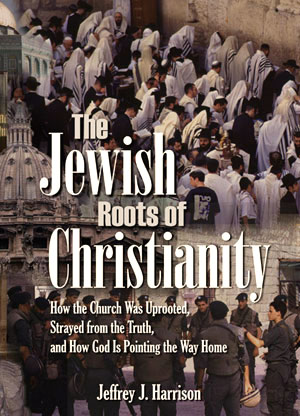
Lecture #1b Audio
Jews and Gentiles in the Body of Messiah
 See notes below. (Sections in parentheses are covered in the longer form of this seminar and in the book version: available in print and on Kindle.)
See notes below. (Sections in parentheses are covered in the longer form of this seminar and in the book version: available in print and on Kindle.)Lecture #1b:
Or click here for more listening options at Internet Archive.
__________________________
Lecture #1b Notes
Should Gentile believers be circumcised [convert to Judaism]?

After these things I will return, and I will rebuild the Tabernacle of David which has fallen, and I will rebuild its ruins, and I will restore it, in order that the rest of mankind may seek the Lord, even all the Gentiles over whom my name has been named
(The kingdom of David: included both Israelites and many different kinds of Gentiles. Only the Israelite portion of his kingdom were required to obey the Law of Moses.)
The Three Exceptions: Acts 15:20: Abstain from [1] things contaminated by idols, and [2] from sexual immorality, and [3] from what is strangled and from blood.
Why only these three? The Romans recognized that murder and robbery were wrong, and had courts. Blasphemy was only with the actual name of God (Yhwh) that only the priests knew.
Acts 15:28: It seemed good to the Holy Spirit and to us
(The prohibition of blood: Was observed by Christians around the world for more than 1,000 years. It is still observed in the Eastern Church today.)
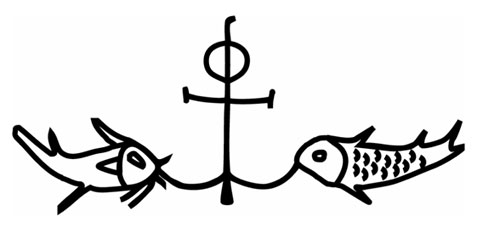
Discovery: Early church mosaics that show the Church as two women, one representing the believers from the circumcision,
the other believers from the uncircumcision.
(See Rom. 3:30, 4:9-12, 15:8-9; Gal. 2:7,12; Eph. 2:11; Col. 4:11.)
Eph. 2:14-15: For he himself is our peace, who made both [Jewish Christians and Gentile Christians] one, and broke down the dividing wall...that in himself he may create out of the two one new man.
THE FIRST JEWISH REVOLT
The First Revolt of the Jews: The war against Rome from AD 66-73 first broke out in the city of Caesarea, the same city where God first poured out his Holy Spirit on the Gentiles (Acts 10:44-48). In AD 70, the city of Jerusalem and the Temple were destroyed.
Nero: The Roman Emperor at the outbreak of the war.
Vespasian: The Roman general placed in charge of the war against the Jews. He began in the north by attacking Jotapata, Tiberius, and Magdala (home of Mary Magdalene). He also took Gamla. (See map below)
Luke 21:20-22: But when you see Jerusalem surrounded by armies, then know that her desolation is near. Then let those who are in Judea flee to the mountains, and let those who are in the midst of the city depart, and let not those who are in the country enter the city; because these are days of vengeance, in order that all things which are written may be fulfilled.
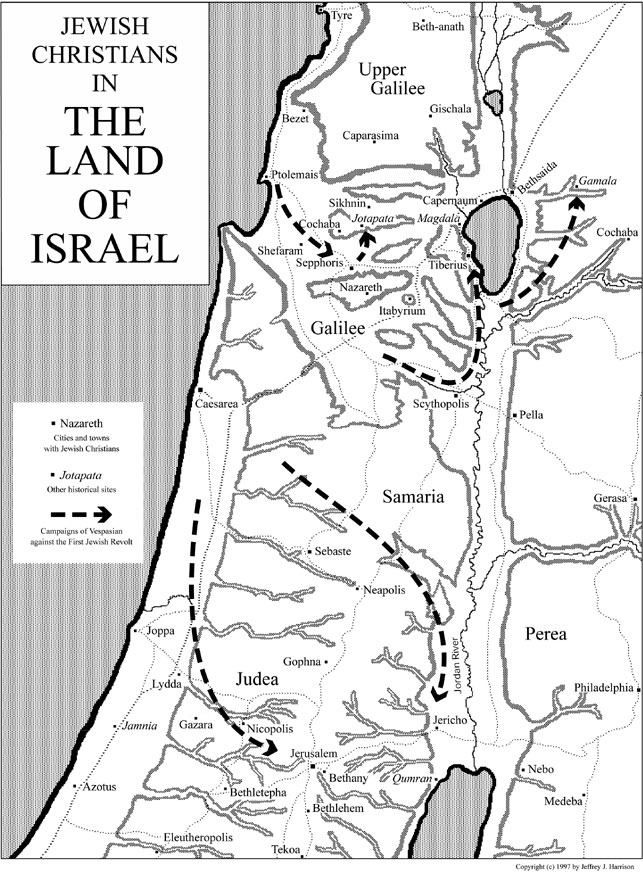
Vespasian: Became emperor after the death of Nero. He sent his son Titus to finish the war in Judea (AD 70).
Luke 19:43-44, 21:24: For the days will come upon you when your enemies will throw up a siege bank before you, and surround you, and hem you in on every side, and will level you to the ground and your children within you, and they will not leave in you one stone upon another.... For there will be great distress upon the land, and wrath to this people, and they will fall by the edge of the sword, and will be led captive into all the nations
Jer. 30:7: It is the time of Jacob’s distress
(Matt. 24:21: For then there will be a great tribulation
)
Sadducees and Zealots: Disappear from history after the war.
Essenes: Religious group living in the desert. The famous Dead Sea scrolls were books kept in their library. They never came back to get their precious scrolls.
Johannan ben Zakki: A famous Jewish rabbi, a Pharisee, who snuck out of the siege of Jerusalem in a coffin. He set up a school in Yavne (Jamnia). This is the beginning of modern Rabbinical Judaism. Sacrifices in the Temple were replaced by prayer and acts of mercy (mitzvoth).
THE JEWISH CHRISTIANS (THE NAZARENES) AND THE RABBIS

Discovery: A Nazarene synagogue in Nazareth with a Jewish ritual bath (a mikveh) used for Christian baptism (see diagram which is of a portion of the mosaic floor of this synagogue).
Discovery: A Nazarene house-synagogue at Capernaum (the traditional house of Peter’s mother-in-law).
(Birkhat ha-Minim: the blessing
of the heretics [minim], AD 90: Actually a curse said against the heretics that was added to the daily benedictions. May the heretics [minim] perish.
In some places, May the heretics and the Nazarenes perish.
)
(Hanina, nephew of Rabbi Joshua (AD 80-120): Accepted the truth of the gospel. Sent by Joshua to Babylon so he would not come under the influence of Jewish Christians.)
(Eleazer ben Dama, nephew of Rabbi Ishmael (AD 120-140): Ishmael rejoiced to see his nephew die rather than be healed by the prayer of a Jewish Christian (Jacob of Kefar Sekaniah).
THE BAR KOCHBA REVOLT
Bar Kochba Revolt (132-135 AD): The second Jewish revolt against the Romans.
Simeon son of Kosiba: Leader of the second revolt. Rabbi Akiva said he was the Messiah. He called him Bar Kochba (Son of the Star
; Num. 24:17: A star will come forth from Jacob
).
(For in the present Jewish war it was only Christians whom Bar Kochba, the leader of the rebellion of the Jews, commanded to be punished severely, if they did not deny Jesus as the Messiah and blaspheme him
(Hegesippus as recorded in Eusebius, History 4.8.4).
(Debates with the rabbis: Provide direct evidence that the early Jewish Christians (the Nazarenes) believed in the Trinity. In their debate they referred to the same verses Christians still use today:
- Gen. 1:26:
Let us make man in our image
- Gen. 11:7:
Come, let us go down and there confound their language
- Gen. 35:7:
Because there God had revealed [plural] himself to him [Jacob]
- Deut. 4:7:
For what great nation is there that has a god so near [plural] to it as is the Lord our God whenever we call on him?
- 2 Sam. 7:23:
And what one nation on the earth is like your people Israel, whom God went [plural] to redeem for himself
- Dan. 7:9:
Until thrones [plural] were set up, and the Ancient of Days took his seat
(Celsus: Pagan writer who recorded the widely held Jewish view that Jesus was the product of adultery between Mary and a Roman soldier. Also found in the Talmud.)
(The Nazarenes also reject the rabbis:
- Isa. 8:19:
mediums and spiritists
understood as a prophetic reference to the rabbis - Isa. 9:1:
gloom
a reference to the rabbis - Isa. 9:4: the
yoke
that God promised to break is the teaching of the rabbis - Isa. 29:20-21: they
defraud
andensnare
withmeaningless arguments
(Merkabah Mysticism: A spiritistic, secret mystical tradition engaged in by some of the most well-known rabbis, including Johanan ben Zakkai and Rabbi Akiva. They pursued trances in which they sought to gain knowledge from angelic authorities. This is the ancient origin of what is known today as Kabbalah.
(Gematria: Jewish Numerology: Also began at this time.)
REJECTION OF JEWISH CHRISTIANITY BY GENTILE CHRISTIANS
(Justin Martyr [150]: Had no objection to Jewish believers that keep the Law, as long as they don’t try to convince Gentiles that they, too, must keep the Law. But he knew of others who thought that even Jewish believers who kept the Law could not be saved!
By the 3rd cent.: Most Christian writers considered all Jewish Christians heretics—because they kept the Law.
Council of Nicea (325): Anti-Judaism was sealed into church law when it decided that the Church should separate from the detestable company of the Jews
and that we should have nothing in common with the Jews.
Christians were now forbidden to participate in Jewish worship, or to attend Jewish synagogues or Jewish feasts.
Vow required of a Jew who wanted to become a Christian: I renounce all customs, rites, legalisms, unleavened breads and sacrifices of lambs of the Hebrews, and all the other feasts of the Hebrews…and fasts, and new moons, and Sabbaths, and superstitions, and hymns and chants and observances and synagogues, and the food and drink of the Hebrews; in one word, I renounce absolutely everything Jewish, every law, rite and custom…and if afterwards I shall wish to deny and return to Jewish superstition, or shall be found eating with Jews, or feasting with them, or secretly conversing and condemning the Christian religion instead of openly confuting them and condemning their vain faith, then let the trembling of Cain and the leprosy of Gehazi cleave to me, as well as the legal punishments to which I acknowledge myself liable. And may I be anathema in the world to come, and may my soul be set down with Satan and the devils.
(From David Stern, Messianic Jewish Manifesto, JNTP, Jerusalem, 1991, pp. 54-55.)
By the early 5th cent.: Jewish Christians could be found in all the synagogues of the East among the Jews
(Jerome)—in other words, outside the influence of the Roman Empire.
By the late 5th cent.: Jewish Christians had disappeared from Israel. For all practical purposes, Jewish Christianity disappeared from history for 1,500 years.
(BELIEFS OF THE JEWISH CHRISTIANS [THE NAZARENES]
Spirit as feminine: The Hebrew for wind
or spirit
(ruach) is a feminine noun in Hebrew.
Gospel of the Hebrews: Probably a Hebrew version of Matthew, perhaps the original from which our Greek Matthew was later translated. (This is not the same as the DuTillet, Munster, or Shem Tob manuscripts.) Perhaps the source of the story of the woman caught in adultery in John 8.
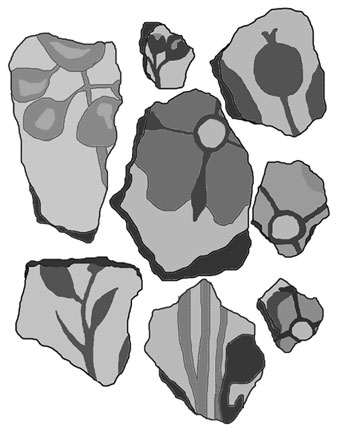
Discovery: Jewish Christian archeological sites (Capernaum, Nazareth, etc.) have no images of animals or humans. This is evidence that they continued to observe the Law of Moses, which forbid images (see diagram).
Discovery: Jewish Christian (Nazarene) artistic designs include:
- Flowers, probably a symbol of Paradise (Gan Eden)
- Ladders, a symbol of Jesus’ heavenly descent and ascent (Gen. 28:12, John 1:51)
- Nets, a symbol of fishing for the souls of men
- Wreaths, a symbol of the victor’s crown to be given to victorious saints (2 Tim. 4:8, James 1:12, 1 Peter 5:4)
- Crosses, a symbol of salvation from the wrath to come (Eze. 9:4). This includes the cross as the tree of life, and the cross with a yod.
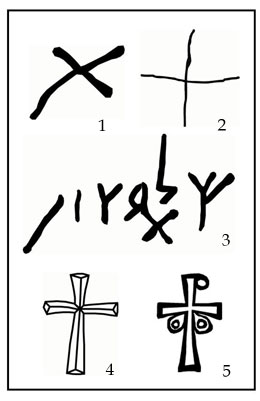
As by means of a tree [the tree of knowledge] we were made debtors to God, so also by means of a tree [the cross/tree of life] we may obtain the remission of our debt(Irenaus, Against Heresies 5.17.3)
Death was in a tree [the tree of knowledge] and life also was concealed in a tree [the cross/tree of life].... The man who believes in Christ eats of the tree of life
(Commodian, De Centesima 321-322,327,33)
The way of the tree of life
of Gen. 3:24 is therefore also the way of the cross, the Way of Jesus, that leads to the Paradise of God (Gan Eden).
Eating of the fruit of the tree of life is being nourished by the commandments of Almighty God
(De Centesima, 330)
Baptism:
- 1) Initial examination
- 2) Instruction in Christian doctrine: the teaching of the two ways.
- 3) Fast: repentance and purification from evil, casting out of demons (insufflation)
- 4) Anointing with oil before baptism
- 5) Renunciation of Satan
- 6) Baptism in water by total immersion (as in the Jewish mikvah)
- 7) Laying on of hands to receive the Holy Spirit
- 8) A second anointing with oil in the form of a cross (the
seal
of the Holy Spirit) - 9) Clothed in white clothes
- 10) Milk and honey, a symbol of the Promised Land
- 11) A palm wreath crown was placed on their heads, a symbol of victory
Origen learned from a Jewish Christian that the angels in Isaiah 6:1-3 were the Son and the Holy Spirit crying out before the Father, Holy, Holy, Holy.
Messenger Christology: Christ as the Messenger (the Angel
) of God:
- 1) The angel that spoke as God to Hagar, identified as
the Lord
(Gen. 16:7,10,13; 20:17,18). - 2) One of the three
men,
identified asthe Lord,
that appeared to Abraham (Gen. 18:1,2,13,22; 19:1,24). - 3) The angel that spoke as God to Abraham at his offering of Isaac (Gen. 22:15-18).
- 4) The angel that identified himself as
God
to Jacob at Bethel (Gen. 31:11,13). - 5) The
man
identified asGod
that wrestled with Jacob at Peniel (Gen. 32:24,28,30). - 6)
The angel who has redeemed me from all evil
(Gen. 48:16). - 7) The angel identified as
God
that spoke to Moses from the burning bush (Exo. 3:2,4). - 8) The angel that has God’s Name in him that went before the children of Israel in the desert (Exo. 23:20-22).
- 9) The appearance of God before Moses and the seventy elders (Exo. 24:10).
- 10) The
Lord
who descended and stood by Moses as theLord
passed by in front of him (Exo. 34:5,6). - 11) The
man,
the captain of the Lord’s army, identified asthe Lord,
that spoke to Joshua (Joshua 5:13-15, 6:2). - 12) The angel that spoke as God at Bochim (Jud. 2:1-5).
- 13) The angel identified as
the Lord
that spoke to Gideon (Judges 6:11,14). - 14) The angel, identified as a
man of God
andGod,
who appeared to the parents of Samson (Judges 13:3,6,8,22). - 15) The saving angel of God’s presence (Isa. 63:9)
- 16) The man glowing like metal (Eze. 1:26-27)
- 17) The radiant man of Daniel (Dan. 10:5-6).
- 18) The angel of great counsel (Isa. 9:6-7 in the old Greek [LXX or Septuagint])
The Book of Revelation:
- 1) The angel clothed with the cloud (Rev. 10:1 and Eze. 1:27,28).
- 2) The angel with the incense (Rev. 8:3-5 and Heb. 7:25, 9:11,15; Rom. 8:34; 1 Tim. 2:5; Luke 12:49)
- 3) The angel
similar to a son of man
sitting on a cloud (Rev. 14 and Matt. 24:30, Mark 4:26,29)